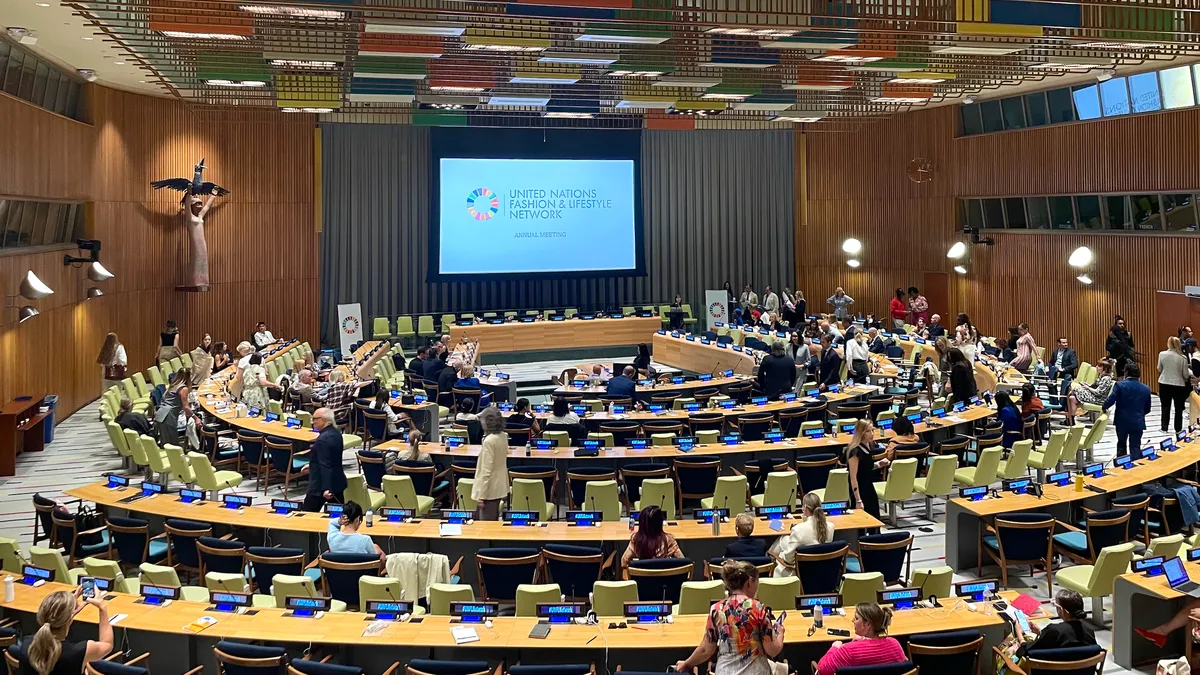NEW YORK — Sustainable fashion practices — and how to incorporate them into companies’ product design, supply chains and corporate decision-making — was the overarching theme at the United Nations Fashion and Lifestyle Network annual meeting Monday.
The third iteration of the event gathered sustainability leaders, academic experts, industry stakeholders and UN representatives and advisory committee members from across the globe with the aim of accelerating implementation of the UN’s sustainable development goals.
Attendees proposed solutions the fashion industry could undertake to curb its carbon footprint throughout panel discussions, emphasizing the dire need of addressing the sector’s role in global carbon emissions.
“I believe in the very urgent need for the industry to dramatically change its ways,” Anders Sjoblom, CEO of circular fashion company Recover, told participants gathered at the UN Manhattan headquarters June 3.
The fashion industry and its supply chain were the world’s third-largest polluter, according to a 2021 World Economic Forum report. A separate study from the European Parliament found the sector emitted almost 10% of the world’s greenhouse gas emissions annually, more than those generated by international flights and maritime shipping combined.
If the fashion industry continues on its current trajectory, it is estimated it will use up more than 26% of the world’s carbon budget in efforts to limit global warming to an additional 2°C by 2050, according to the Ellen MacArthur Foundation.
Solving the issue through recycled and sustainable fibers
The use of regenerative or recycled fabrics, in particular, was one of the solutions proposed for slashing the industry’s emissions, especially those that stemmed from the textile sector.
Sjoblom, who joined Recover after a decade at the H&M Group, vouched for recycled cotton. Spain-based Recover has specialized in the sustainable material for over 75 years by turning textile waste into recycled cotton fiber and cotton fiber blends.
“Recycled cotton is the cheapest, lowest cost fiber you can use from recycled fibers,” Sjoblom said. “It is also the lowest impact sustainable fiber out of all [recycled fibers].”
Sharon Perez, a senior executive from the Lenzing Group, echoed Sjoblom’s proposal of a metamorphosis in fibers used in a separate panel. Lenzing Group produces and sells wood-based fibers and cellulose derived from renewable resources and resource-conserving technology.
“Innovation with natural and cellulosic fibers is becoming more and more important,” Perez said. “A lot of materials developers and designers have been tasked with creating sustainable materials or materials that have a lower environmental impact.”
Perez noted that the production of such fibers impacts and improves not just the apparel sector, but also sectors that specialize in accessories, home textiles and non-woven fabrics.
The Executive Director of the United States Cotton Trust Protocol, Daren Abney, said the U.S. Department of Agriculture launched a program in 2022, in collaboration with 141 different groups, called Climate-Smart Commodities to support farmers, ranchers and private forest landowners and leverage the greenhouse gas benefits of “climate-smart” products.
Abney said the Cotton Trust Protocol was the lead recipient for climate-smart cotton funding, allowing the organization to financially incentivize cotton growers to “integrate new practices that will result in quantified, verified carbon sequestration.”
“What USDA is really doing is playing the field to see if there is an actual market for … brands and retailers that are using cotton inside their supply chain being able to invest in cotton growing practices that are rendering results in terms of cotton sequestration,” Abney said.
The World Economic Forum’s research also found that approximately 10% of emissions from the fashion industry — especially those that were agriculture based — would need to be addressed through nature-based solutions, such as sustainable growth of cotton. Recycling, on the other hand, could reduce the industry’s emissions by almost 2%, according to the research.
Education is key when pushing for greener practices
Some speakers at the event, which included university professors and circular fashion specialists, advocated for tackling the problem by educating the masses about the importance of sustainable practices. This entails breaking down the message for producers, suppliers and consumers alike.
Yvonne Watson, the interim executive dean of the Parsons School of Design, said the institution had made a “huge commitment towards sustainability.” The school introduced a core course in the curriculum that all first-year students are required to take called “Sustainable Systems.” The focus of the course is climate, environment, energy and water, which aims to inform students about how fashion impacts the world, Watson said during a panel.
“We see everything that is evolving in regard to climate and the ways in which fashion is impacted … it is incumbent on us to bring new solutions forward,” Watson said.
Jean Hegedus, director of sustainability at The Lycra Company — which specializes in innovative fibers, including spandex — stressed that education efforts should extend over to brands and retailers as well, as they are often responsible for setting the price of a garment.
Historically, sustainable garments or sustainably produced garments have come with a higher price tag than others. This typically has been attributed to their production companies paying fair wages to employees, using eco-friendly materials and investing in renewable energy sources.
Informing consumers about what goes into the production of sustainable clothing items, according to Hegedus, will help influence their decision to purchase the product and have a better appreciation for it.
“[Once] they see the link between the choices that they make and the potential impact of the product, I think there'll be a classic consumer mindset shift,” Hegedus said.


















